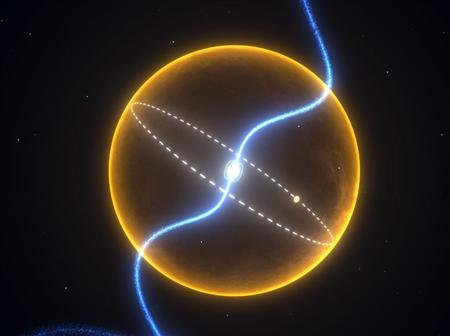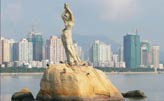Kaleidoscope
Astronomers discover diamond planet
Updated: 2011-08-27 07:56
By Ben Hirschler (China Daily)
Scientists say it's probably the remnant of a massive star
LONDON - Astronomers have spotted an exotic planet that seems to be made of diamond racing around a tiny star in our galactic backyard. The planet is far denser than any other known so far and consists largely of carbon. Because it is so dense, scientists believe the carbon must be crystalline, so a large part of this strange world will effectively be diamond.
 |
|
An exotic planet that seems to be made of diamond racing around a tiny star in our galactic backyard in an undated image courtesy of Swinburne University of Technology in Melbourne. [Photo/Agencies] |
"The evolutionary history and amazing density of the planet all suggest it is comprised of carbon - i.e. a massive diamond orbiting a neutron star every two hours in an orbit so tight it would fit inside our own Sun," said Matthew Bailes of Swinburne University of Technology in Melbourne.
At 4,000 light years away, or around an eighth of the way toward the center of the Milky Way from the Earth, the planet is probably the remnant of a once-massive star that has lost its outer layers to the so-called pulsar star it orbits.
Pulsars are tiny, dead neutron stars that are only around 20 kilometers in diameter and spin hundreds of times a second, emitting beams of radiation.
In the case of pulsar J1719-1438, the beams regularly sweep the Earth and have been monitored by telescopes in Australia, Britain and Hawaii, allowing astronomers to detect modulations due to the gravitational pull of its unseen companion planet.
The measurements suggest the planet, which orbits its star every two hours and 10 minutes, has slightly more mass than Jupiter but is 20 times as dense, Bailes and colleagues reported in the journal Science on Thursday. In addition to carbon, the planet is also likely to contain oxygen, which may be more prevalent at the surface and is probably increasingly rare toward the carbon-rich center.
Its high density suggests lighter elements such as hydrogen and helium, which are the main constituents of gas giants like Jupiter, are not present.
Just what this weird diamond world is actually like close up, however, is a mystery.
"In terms of what it would look like, I don't know I could even speculate," said Ben Stappers of the University of Manchester. "I don't imagine that a picture of a very shiny object is what we're looking at here."
Reuters

Specials

Jewel of the south
Zhuhai in South China has a wealth of natural allure that is open for business.

China in vogue
How Country captured the fascination of the world's most powerful fashion player

More than just a game
Mahjong is a deep-rooted cultural tradition that touches every level of society